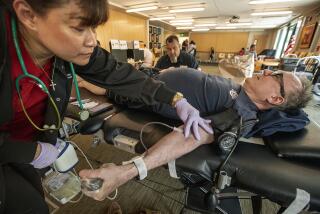Safe blood
- Share via
SOON AFTER THE FIRST AIDS CASES appeared in the U.S. in the early 1980s, the Food and Drug Administration, which oversees the nation’s blood supply, permanently banned practically all gay men from donating blood. At the time, the policy made sense. But a quarter of a century later, there is no longer any scientific reason to continue it.
In the 1980s, thousands of people a year unknowingly contracted HIV, the virus that causes AIDS, from blood transfusions. Gay men were the primary group with HIV-infected blood, and there was no adequate technology to screen for HIV, so the FDA banned gay men from donating if they had been sexually active since 1977.
Today, all donated blood is tested for nine infectious diseases, including hepatitis B, HIV and syphilis. With HIV, two tests are used: The first searches for antibodies produced after an infection; the second, which was added to the process six years ago, looks for the genetic material of the virus. With the two tests, the odds of an HIV-infected batch entering the blood supply are about 1 in 2 million. That means about a dozen people a year contract the virus from transfusions. This result is unfortunate but inevitable; transfusions always carry a certain amount of risk because screening isn’t perfect. About 85 people contract hepatitis C through transfusions each year, for instance, and about 12 are infected with hepatitis B. Roughly 15,000 people die of hepatitis in the U.S. each year, about the same number as die of AIDS.
Moreover, although there is no way to know how many Americans die each year because of blood shortages, allowing gay men to donate would increase the blood supply and potentially save lives.
The nation’s leading blood donation agencies, including the American Red Cross, asked the FDA this year to change its policy. Currently, only gay men, prostitutes, intravenous drug users and people who have a history of cancer or other blood-borne diseases are banned from donating for life. The blood banks have recommended that gay men who haven’t had sex in a year be allowed to donate.
A temporary ban for gay men would still be needed. There’s a window during which an individual can be infected with HIV and not test positive. And gay men in the U.S. have a much higher incidence of HIV infections than the rest of the population. So it’s necessary to exclude those who have recently had sex, even with condoms. But the new tests can detect the virus within 11 days, on average, after infection. A ban of several weeks or months should be sufficient.
Another issue is that current guidelines fail to adequately take donor behavior into account. Questionnaires don’t routinely ask about risky behavior, so even promiscuous heterosexuals can donate. Is blood from a monogamous, HIV-negative gay man more unsafe than blood from a heterosexual man who is sexually active with multiple partners?
The FDA must continue to monitor the nation’s blood supply, and it may be necessary to bar donations from those who engage in risky behavior or who are part of a population that is at a much higher risk for a disease. But those decisions should be made according to science.
More to Read
Sign up for Essential California
The most important California stories and recommendations in your inbox every morning.
You may occasionally receive promotional content from the Los Angeles Times.










